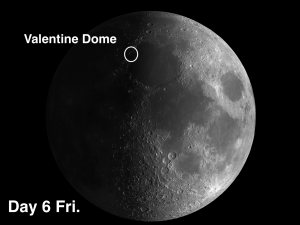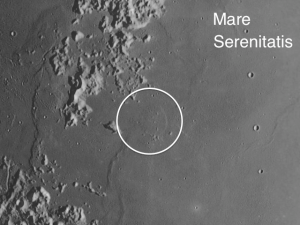 The week of March 19-25 takes us from Day 2 to Day 9. This week we will highlight the so-called Valentine Dome, viewable on Friday night, and the vernal equinox.
The week of March 19-25 takes us from Day 2 to Day 9. This week we will highlight the so-called Valentine Dome, viewable on Friday night, and the vernal equinox.
Valentine Dome: [NE/F11; L=10°E] Keep a close eye on the movement of the terminator, and when it just touches the western shore of Serenity you will be able to make out a 20-mile wide volcanic dome located in what passes for the Straits of Serenity — the gap in the mountains where Serenitatis seems to flow into Mare Imbrium.  This is an unusually large dome that must be caught under a low Sun. Although it does not have an official name, it is popularly referred to as the Valentine Dome because under certain lighting conditions it has a heart shape. Sitting atop the dome are three conspicuous hills (which are accompanied by six smaller ones). They are difficult to see but worth a try.
This is an unusually large dome that must be caught under a low Sun. Although it does not have an official name, it is popularly referred to as the Valentine Dome because under certain lighting conditions it has a heart shape. Sitting atop the dome are three conspicuous hills (which are accompanied by six smaller ones). They are difficult to see but worth a try.
OF ADDITIONAL INTEREST IN SPACE THE WEEK OF MARCH 19-25:
The vernal equinox will happen on Tuesday, March 20th. It is the point in which the center of the Sun passes directly over the Earth’s equator and day and night are approximately the same length–hence “equi” (equal) “nox” (night).
There is a commonly held belief that on the vernal equinox, and only on the vernal equinox, you can stand an egg on its end, and school children in classrooms all across the country will be trying to do this. It will even capture a lot of news media attention, particularly when some of those children are successful. But the truth of the matter is that they are successful not because of the vernal equinox but because eggs have tiny bumps on their ends which, with patience, you can use as a little tripod, and the egg, in a few instances. will stand on end. Try it. With patience and determination you will be successful. Also try it on a day other than the vernal equinox and you will still be successful!
======================
It is highly recommended that you get a copy of Sky and Telescope’s Field Map of the Moon, the very finest Moon map available for use at the telescope. It is available for $10.95 at www.skyandtelescope.com and on Amazon. All features mentioned in this blog will be keyed to the grid on the Field Map and will look like this: Plato: [NW/D9]
Credits:
Courtesy of Gray Photography of Corpus Christi, Texas
Lunar photos: NASA / USGS / BMDO / LROC / ASU / DLR / LOLA / Moon Globe. Used by permission
- Rupes Cauchy: A Best Known Fault on the Moon - July 22, 2024
- Moon Crater Schickard – Crater Floor has Stripes - July 15, 2024
- Moon Craters Langrenus and Vandelinus - July 8, 2024